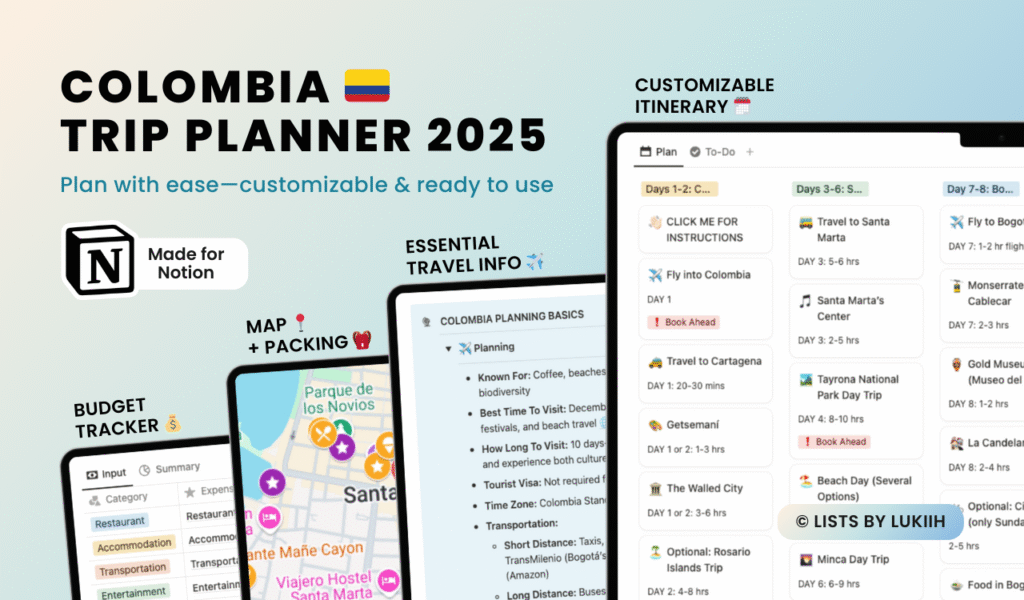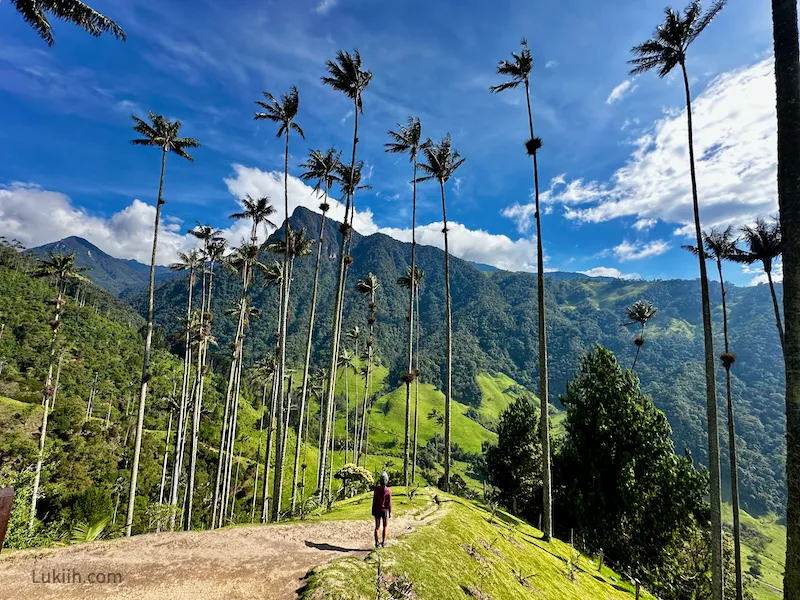- Map
- Overview
- Cartagena (Days 1-2)
- Santa Marta (Days 3-6)
- Bogotá (Day 7-8)
- Medellín (Days 9-10)
- Salento & Cocora Valley (Days 11-14, Option 1)
- Amazon Rainforest (Days 11-14, Option 2)
Lists By Lukiih is readers-supported. When you buy with my affiliate link, I may earn a small commission. Thanks!
📍 Itinerary Map
This itinerary takes you to all of Colombia’s top destinations:
- Cartagena – a city known for the Walled City, a UNESCO World Heritage Site lined with colorful colonial architecture
- Santa Marta – a Caribbean city with pristine beaches and access to mountain areas
- Bogotá – the largest city, known for the neighboring Monserrate mountain peak
- Medellín – famous for two top attractions: Guatapé and Comuna 13
- Salento/Cocora Valley (Option 1) – the coffee region, famous for having the tallest palm trees in the world
- Amazon Rainforest (Option 2) – Colombia’s Amazon region has less tourism infrastructure and provides a more authentic experience compared to Peru’s and Brazil’s
🇨🇴 Planning a Trip to Colombia: 12 Practical Things To Know
🗓️ Itinerary Overview
Below is a great way to spend two weeks days in Colombia. This itinerary is well-researched, highlights major attractions, and reflects lessons from my travel experience.
My Colombia trip planner has this itinerary prefilled with more details and tips.
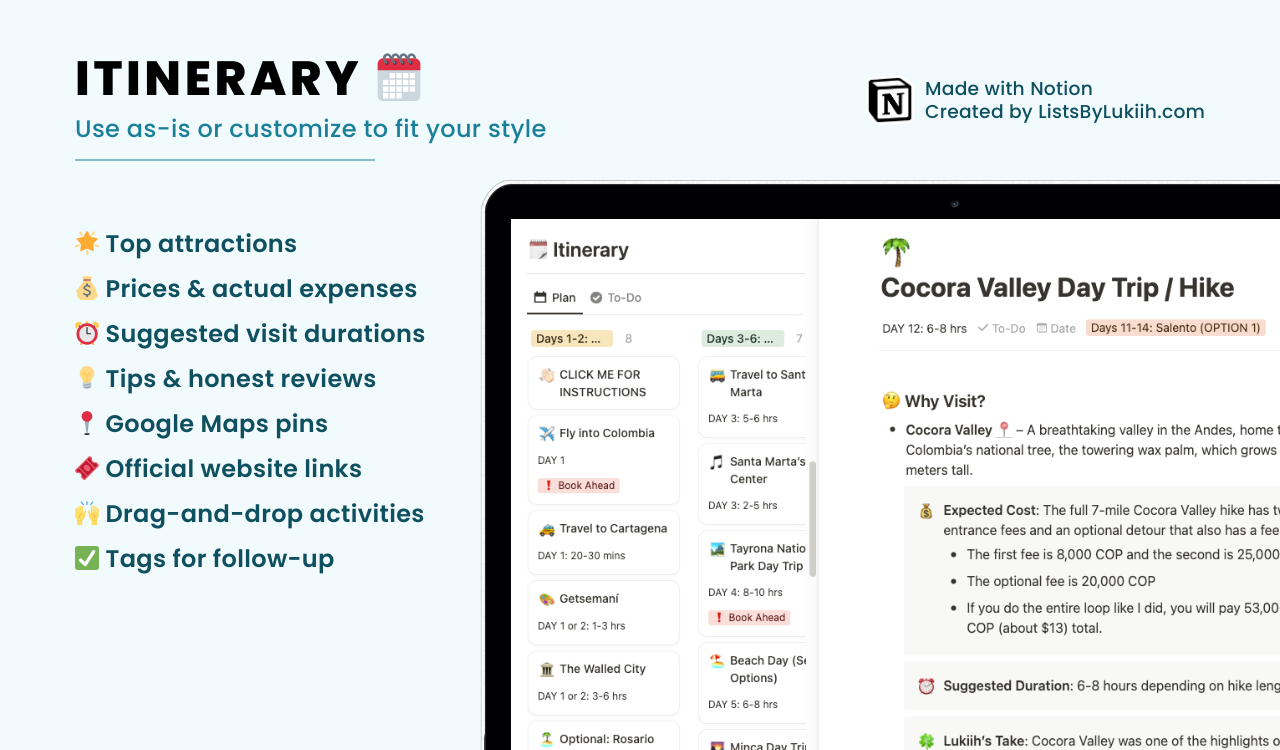
All prices mentioned here are in USD 💵 .
Cartagena (Days 1-2)
Start in Cartagena; its international airport is one of the cheaper top destinations to fly into. Starting in the north also means seeing some of the country’s coastal destinations.
- Cartagena is one of Colombia’s top 3 destinations. Its main attraction is the Walled City, a UNESCO World Heritage Site lined with colorful colonial architecture and cobblestone streets.
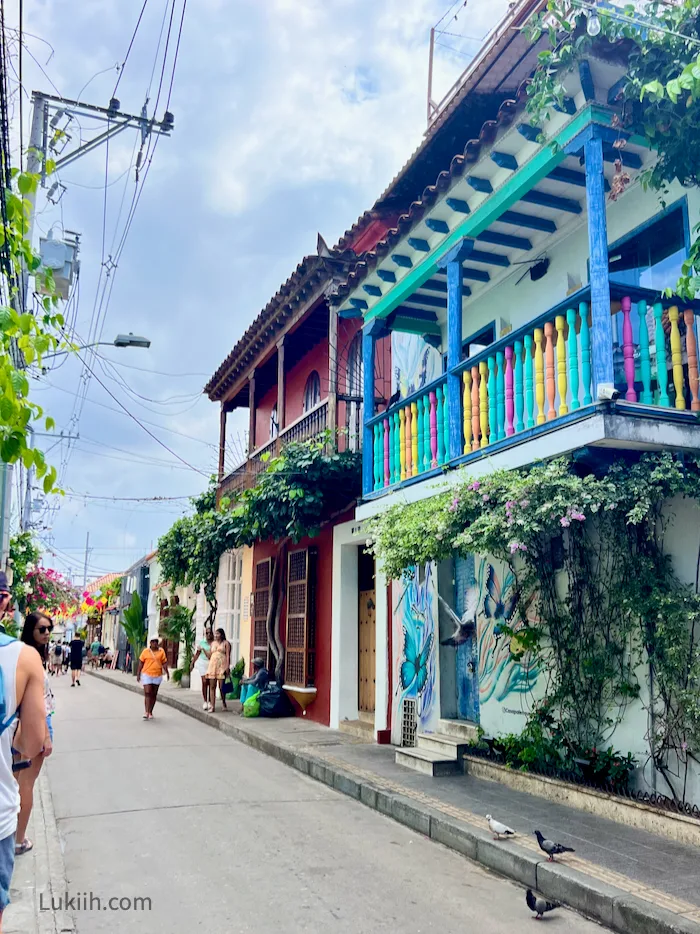
-
- Explore the colorful streets of Getsemani (💰 free)
- Look at sloths, iguanas, and tiny monkeys at Centenario Park (💰 free)
- Wander around the picturesque streets inside the Walled City (💰 free)
- Check out the famous Botero statue at Plaza de Santo Domingo (💰 free)
- Catch the sunset along the 7-mile wall surrounding the Walled City (💰 free)
- Take photos with the traditionally dressed fruit ladies (💰 $3–$5 fee)
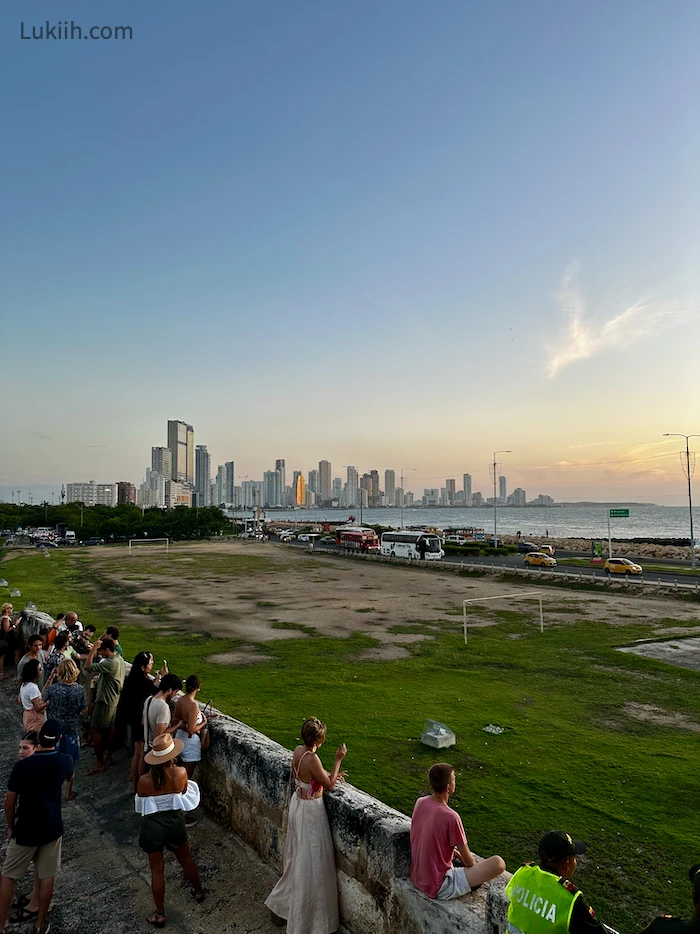
-
- La Palettería – sells refreshing popsicles with unique local fruit flavors
- Restaurante Porton de San Sebastian – a solid Colombian restaurant
- Gelateria Paradiso – popular gelato place selling local flavors
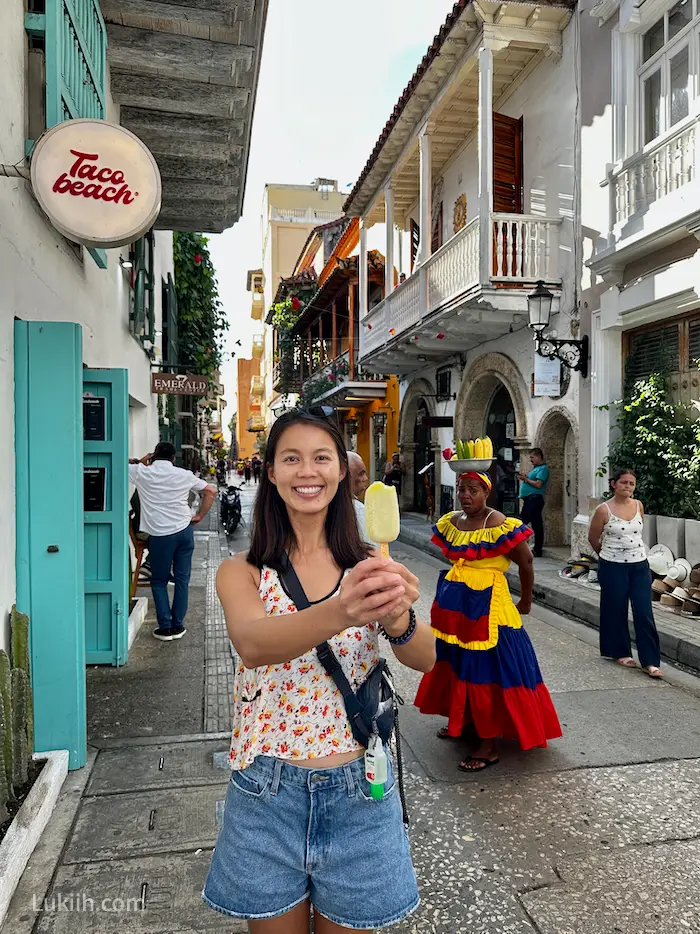
My Colombia trip planner includes reviews of the 35+ places I ate at over several weeks.
- Fly into Cartegena’s international airport, Rafael Núñez International Airport (CTG), and then take a taxi or Uber into the city’s center.
To catch a taxi, walk to the yellow “Taxi” kiosk just outside the customs area. Input your destination and the kiosk will print out a receipt of how much your ride should cost, which you can then hand to a taxi. You won’t be overcharged this way.
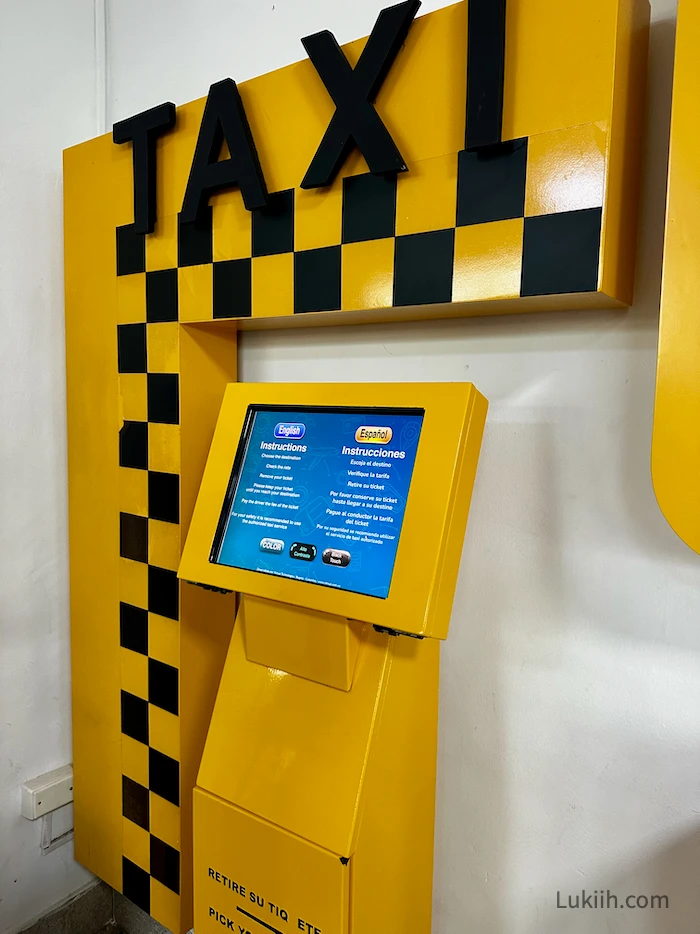
- Cartagena is fairly contained, so there are 3 popular neighborhoods to stay in Cartagena:
- The Walled City – The most popular and happening place, staying here will be loud, and expensive, and you won’t have as many amenities since it’s a protected area (e.g., hot water, AC, etc. are hard to find).
- Getsemani – A very lively and colorful neighborhood as well, but slightly more affordable than the Walled City.
- Bocagrande – The more modern area of Cartagena where you’ll see skyscrapers and have access to the beach. However, it’s further away from the main attractions. I stayed near Descanso Frente al Mar.
Santa Marta (Days 3-6)
On the third day, head to Santa Marta.
- Santa Marta is a city on the Caribbean coast known for its many pristine beaches and access to mountain areas like Minca. It’s particularly famous for Tayrona National Park, which has beautiful beaches, hikes, and wildlife.
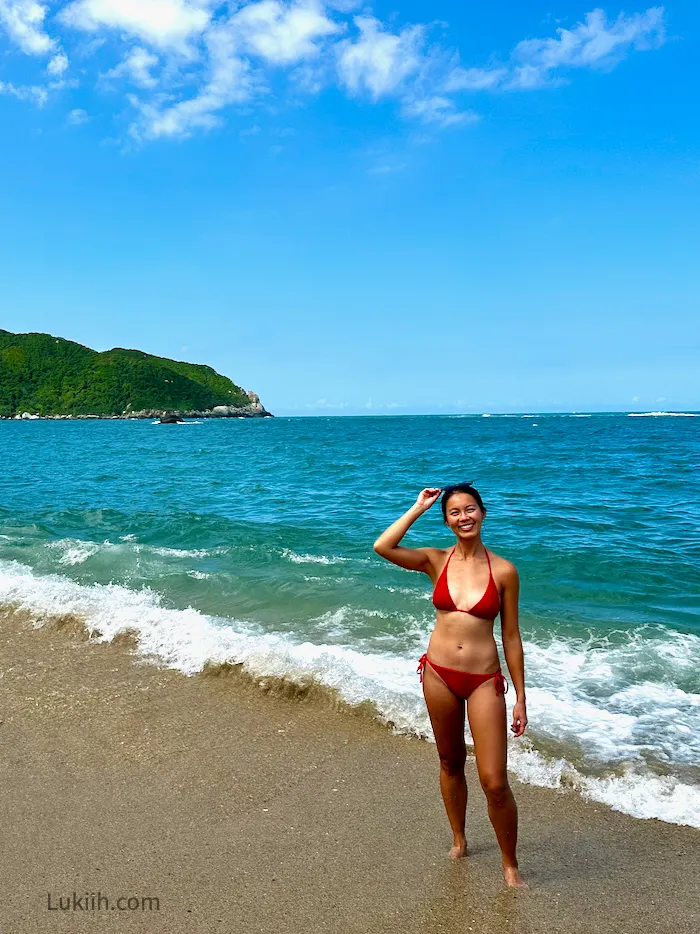
-
- Hike to the beautiful beaches of Tayrona National Park (💰 $20+ entry fee)
- Take a day trip to one of the 10+ beaches in the Santa Marta area (💰 free–$20)
- Visit the mountain area of Minca for waterfalls and coffee (💰 free / $60 tour)
- Enjoy live dances and music at Parque de Los Novios in the center (💰 free)
- Catch the sunset at the nearby Marina or Playa de Los Cocos (💰 free)
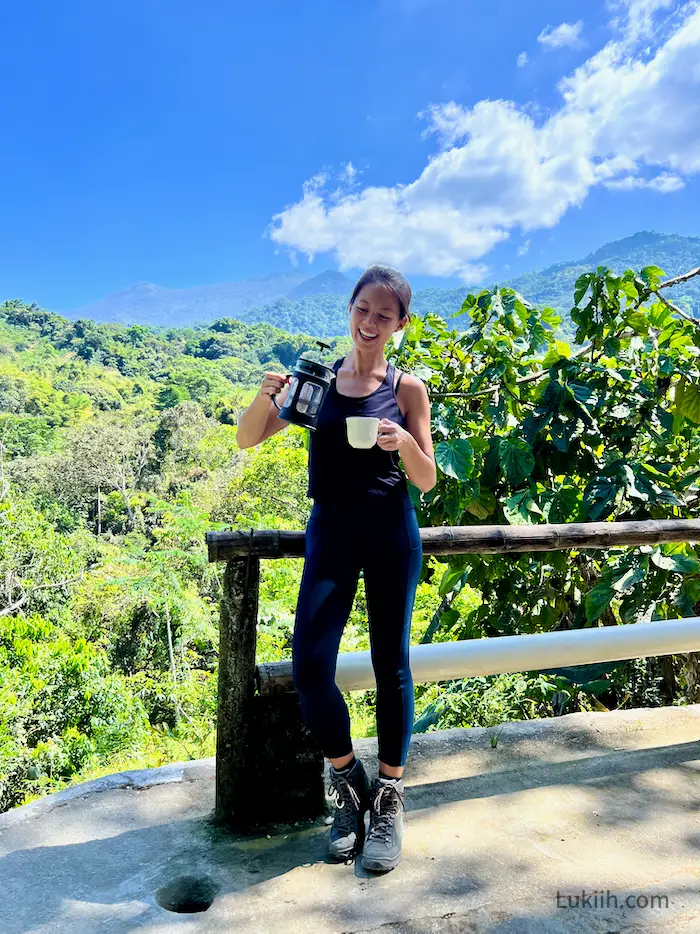
- To get to Santa Marta from Cartagena, you can fly or take a bus. I recommend taking the Berlinastur or Marsol bus because it’s significantly cheaper and doesn’t take much longer than flying.
For details and tips on getting around, see my Colombia trip planner.
-
- Guasimo – a high-end restaurant serving delicious Colombian food
- Nevossa – ice cream place serving delicious local flavors
- Creole Mar Y Cafe – reasonable seafood place with huge portions
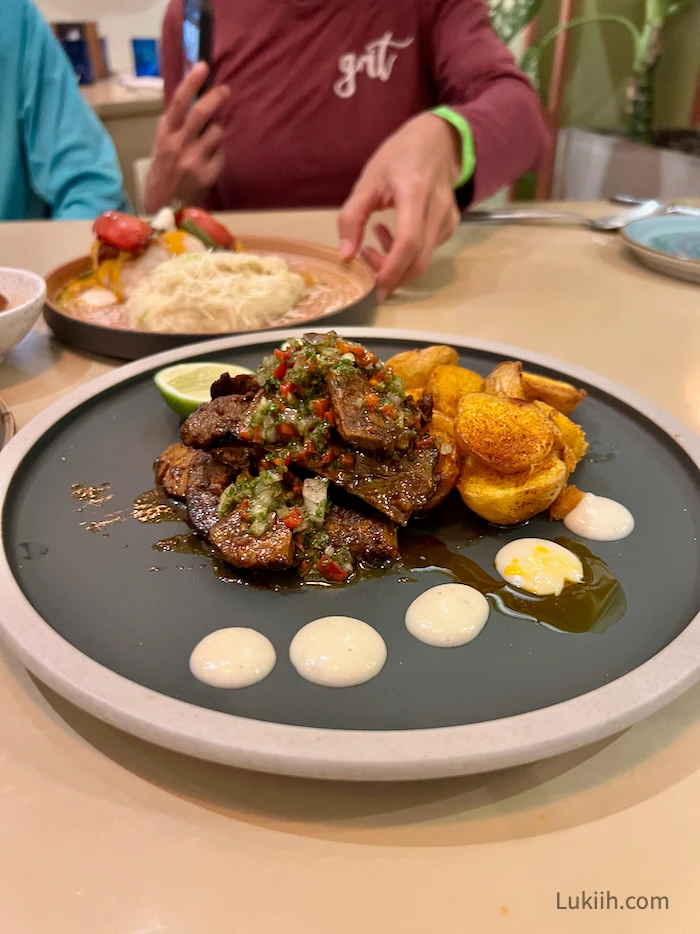
- You can generally stay in two areas in Santa Marta:
- Santa Marta’s center – you’ll be near all the restaurants and action, but it will be quite loud until late in the night.
- Outskirts of Santa Marta – I recommend staying on the south side (instead of the north or east side) because you’ll be closer to the lively dining area. I stayed at a unit in Las Palmitas.
Bogotá (Day 7-8)
Travel to the capital on your seventh day.
- Bogotá is the largest city in Colombia, known for the nearby Monserrate Mountain and world-class museums like the Museum of Gold.
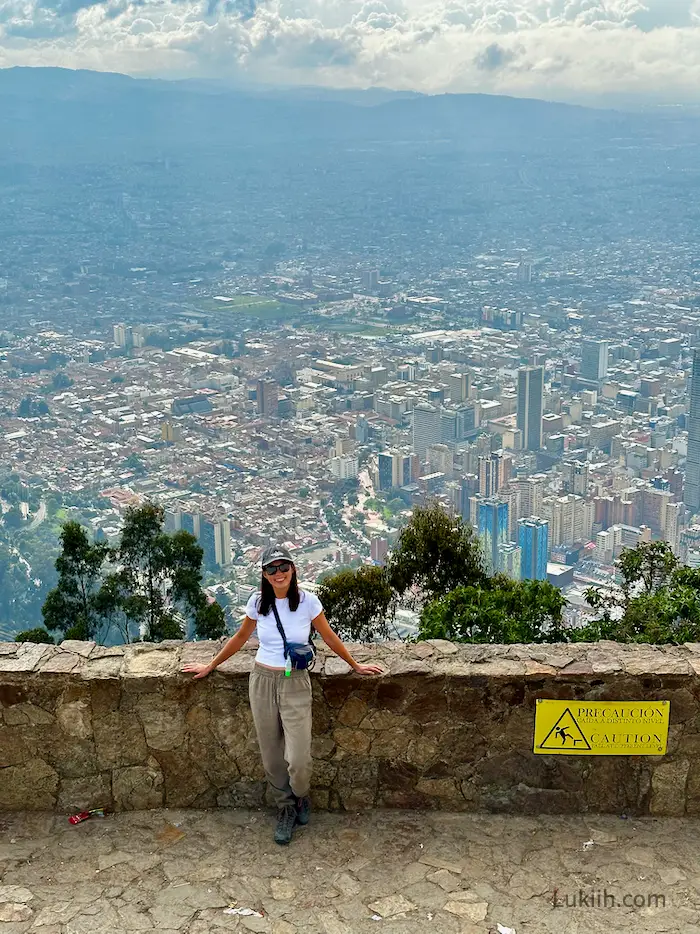
Bogotá has a bad reputation for being dangerous to walk around at night, but I found it pleasant to explore certain areas like Zona T.
-
- Take a cable car up Monserrate Mountain for a great city view (💰 $7 ride / $25 guide)
- Learn about gold in the world-class Museum of Gold (💰 $2 entry fee)
- Learn about Colombia’s most famous artist in the Botero Museum (💰 free)
- Explore La Candelaria, Bogotá’s historic center (💰 free)
- Rent a bike and participate in the weekly Ciclovía (💰 $3–$10 for rentals)
- Relax at one of the city’s many parks, particularly Simón Bolívar Park (💰 free)
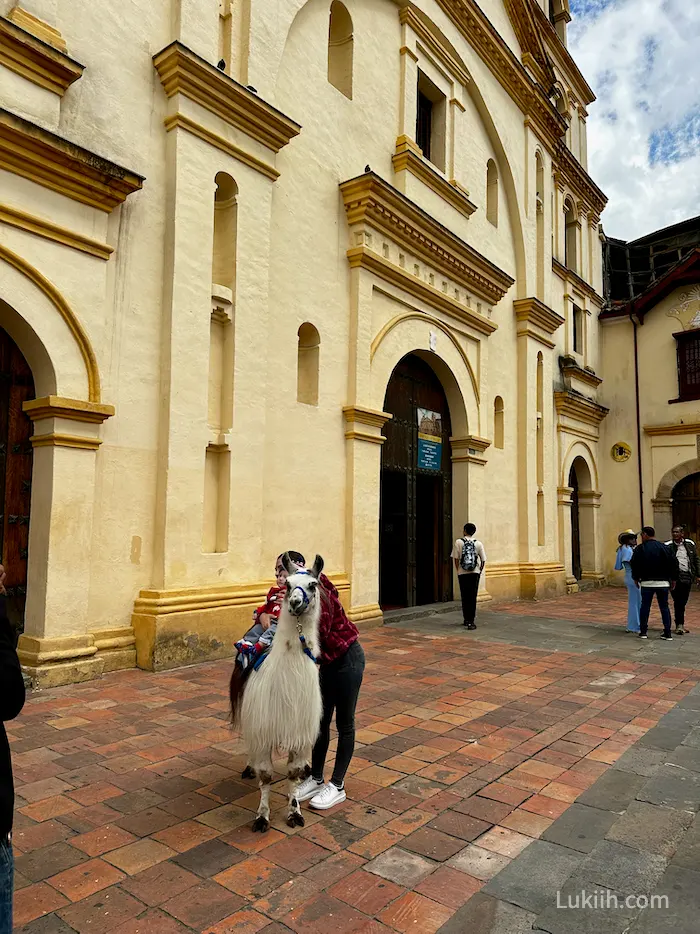
-
- La Puerta Falsa – serves my favorite hot chocolate and cheese (a typical combination in the country)
- Home Burgers – my favorite burger place in Colombia that serves burgers medium-rare
- La Esquina Vegetariana – my favorite vegan restaurant with amazing menú del días
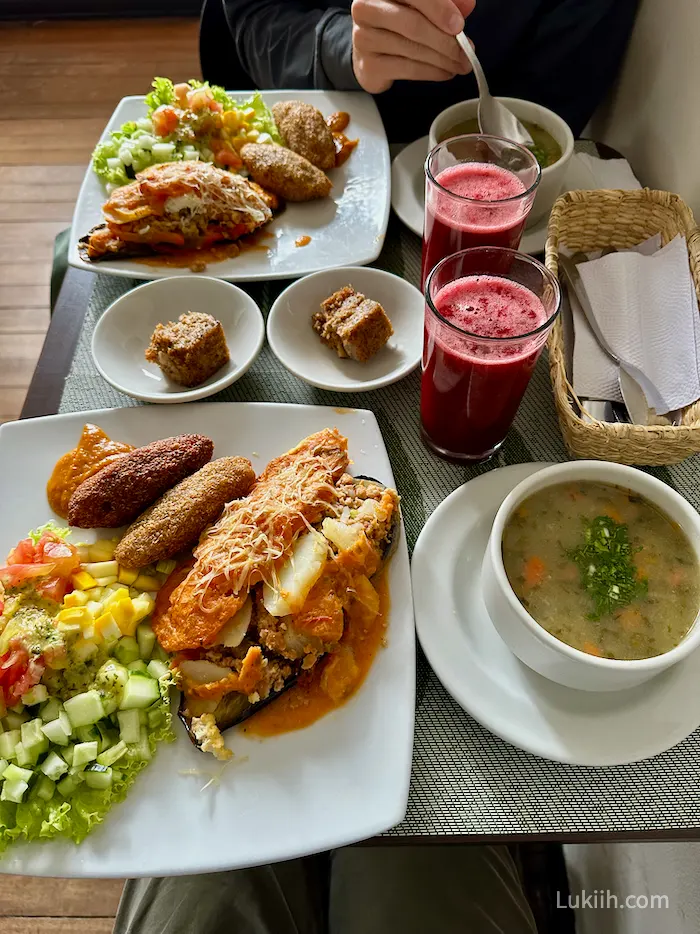
- The best way to get to Bogotá is to fly into the country’s largest international airport, El Dorado International Airport, and then take an Uber into the city.
- Bogotá has many affordable and nice housing options, so it’s more important to prioritize the neighborhood’s vibe:
- La Candelaria – If you’re only staying in Bogotá for a short time to see the main tourist attractions, I recommend staying in La Candelaria to easily access these attractions. I stayed in Apartaestudios La Candelaria when I was here.
- Zona Rosa – If you’re staying in Bogotá for more than a couple of days, consider staying in the high-end, comfortable, and safe area of Zona Rosa. I stayed at the nearby Tuliv Moderno for two weeks.
- El Chicó – El Chicó is within walking distance of Zona Rosa and is slightly more affordable but still safe.
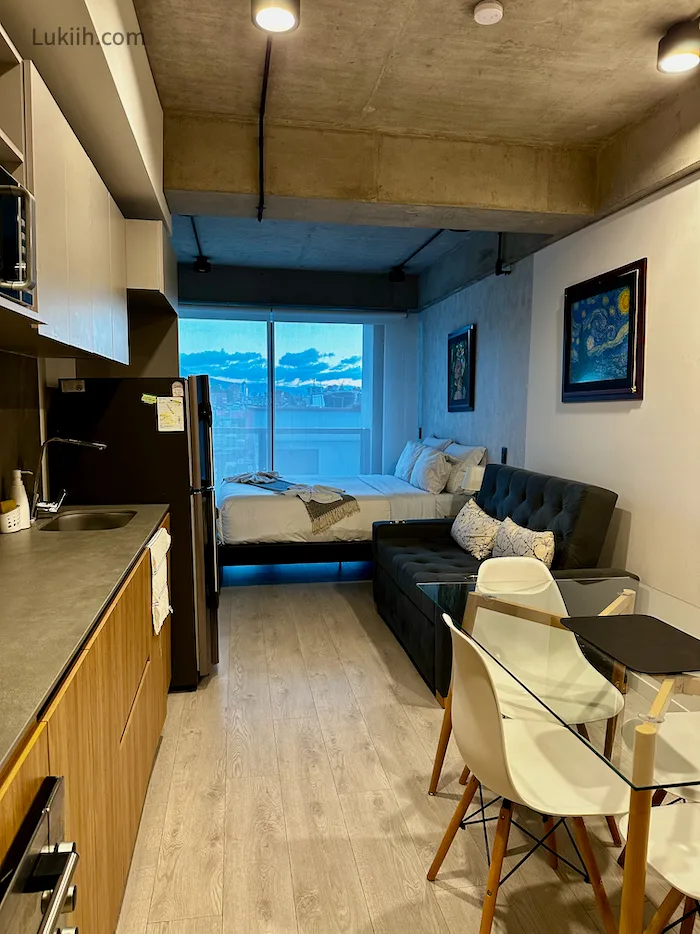
My Colombia trip planner has more tips on visiting Bogotá.
Medellín (Days 9-10)
Afterward, head to the city with two famous attractions.
- Medellín is the second-largest city in Colombia, known for its bustling center and modern public transportation. It’s nestled between the Andes Mountains and has two famous attractions: Guatapé and Comuna 13.
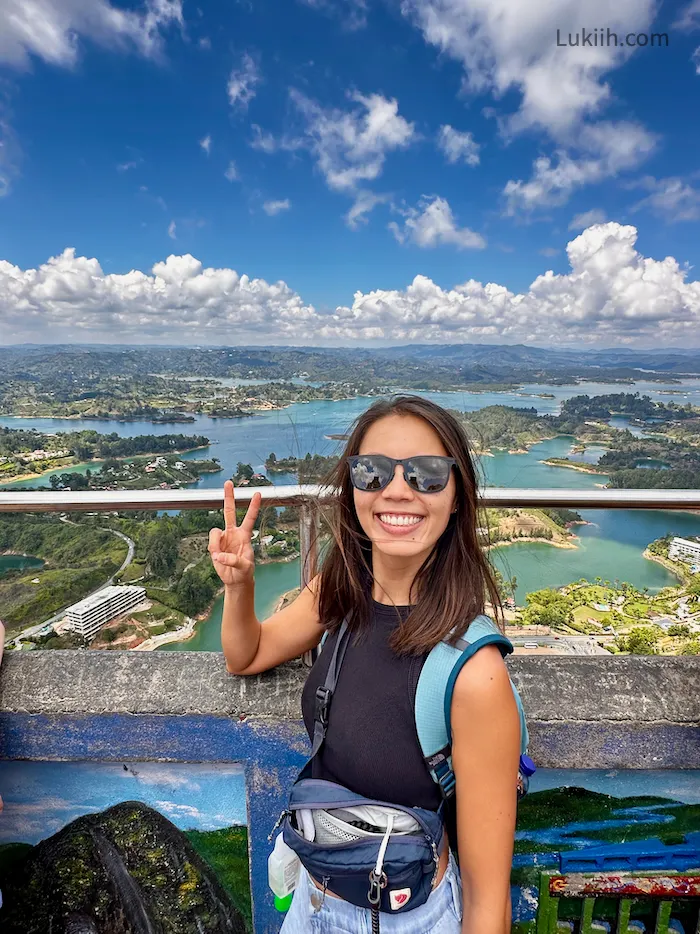
-
- See the crowded, vibrant neighborhood of Comuna 13 (💰 free / $20 tour)
- Climb the iconic Piedra del Peñol rock formation in Guatapé (💰 $30+ tours)
- Hike one of the trails in Parque Arvi (💰 $15 entry fee)
- Check out Plaza Botero in Medellín’s bustling center (💰 free)
- Relax and enjoy the outdoors at the Botanical Garden of Medellín (💰 free)
- If you have more time, visit the stunning Cueva del Esplendor (💰 $5 entry fee)
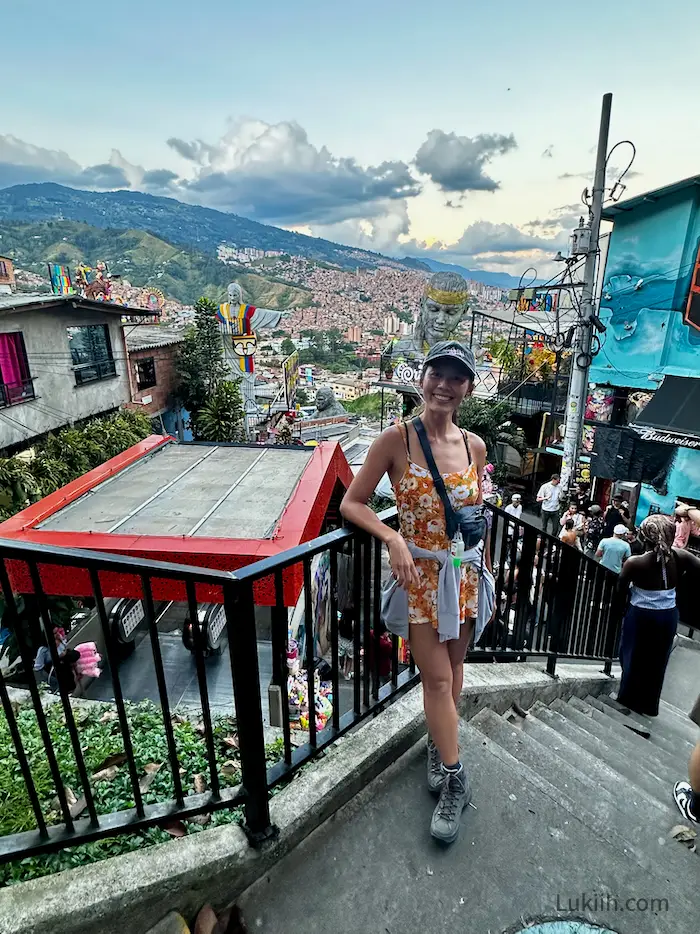
-
- Rituales Café – one of my favorite coffee places in the city (but their expresso-based drinks were just decent)
- Uno más uno Restaurant – serves my favorite menú del día in the city
- Santa Leña Laureles – an aesthetic cafe with really good baked goods
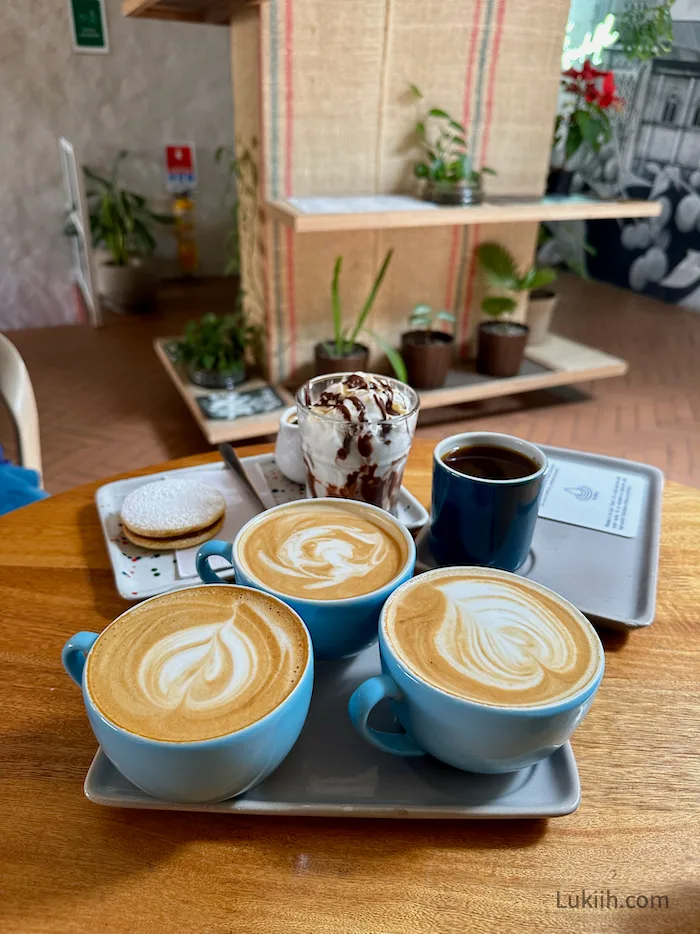
- The best way to get to Medellín is to take a flight to José María Córdova International Airport and then take the Aeropuerto-Combuses bus into the city center. The bus is not only faster but also cheaper than taking a taxi or Uber.
- Like Bogotá, accommodations in Medellín are relatively nice and affordable, so choosing a neighborhood is the more important factor. The two most popular tourist neighborhoods are:
- El Poblado – An upscale and safe but touristy neighborhood that is home to the vibrant nightlife scene in Medellín.
- Laureles – A quieter, upscale, and safe residential neighborhood that has plenty of restaurant options. I stayed a bit north of Laureles to save on costs.
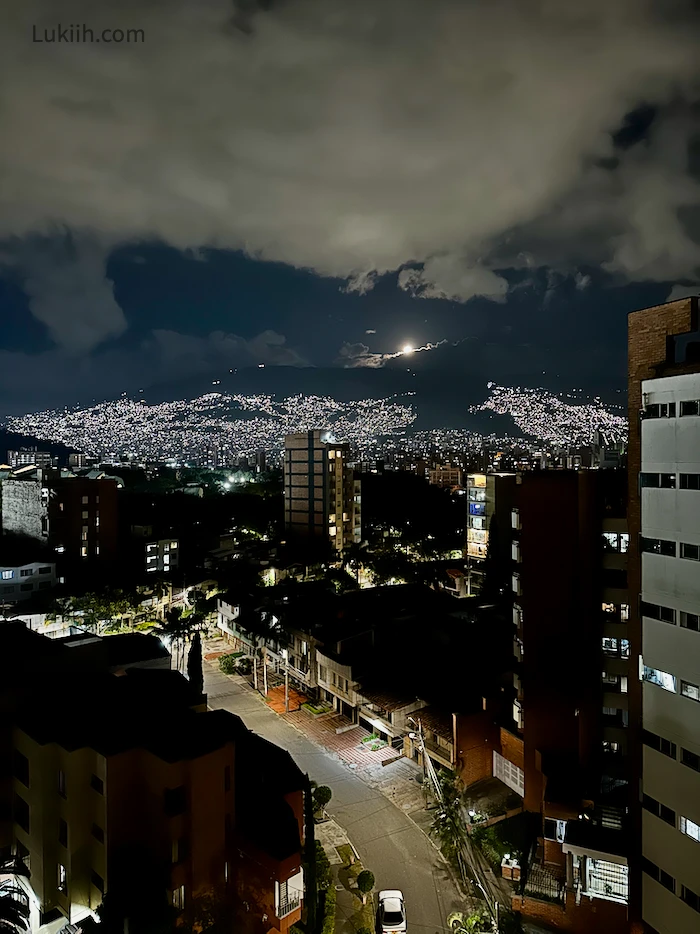
Salento & Cocora Valley (Days 11-14, Option 1)
Finish your trip in the coffee region of Colombia.
- Salento is a cute, contained town in the heart of Colombia’s coffee region. It is one of the country’s most popular destinations because it is the gateway to the unique Cocora Valley, a stunning landscape that is home to many towering wax palm trees, the national tree.
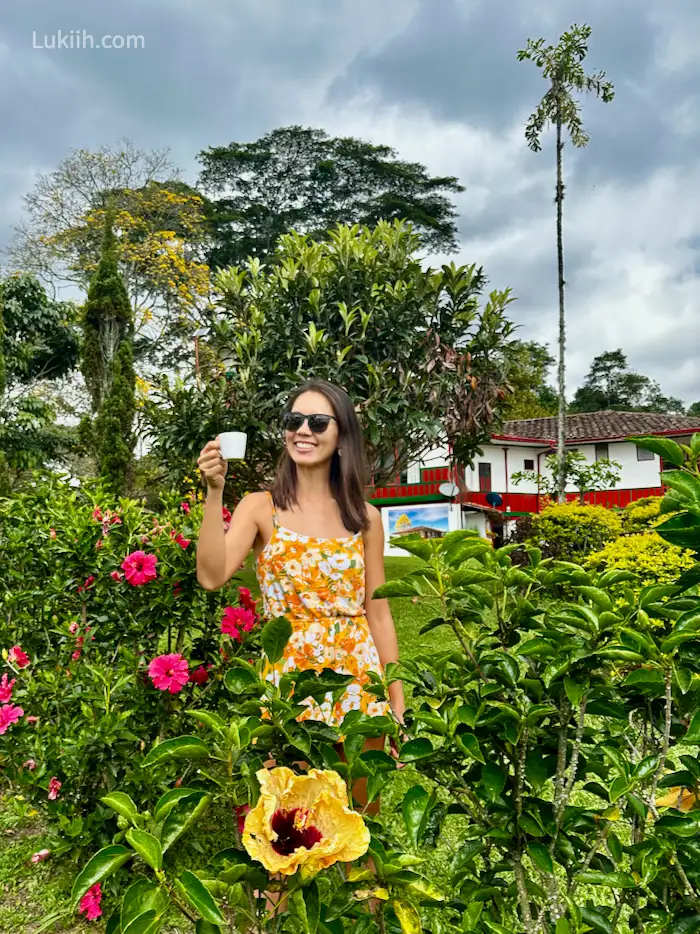
-
- Take a day trip and hike along the stunning Cocora Valley (💰 $15+)
- Take a coffee tour in one of Salento’s 10+ coffee farms (💰 $15–$90 tours)
- Alternatively, hike to several coffee farms to do several coffee tastings (💰 $10+)
- Explore the colorful town of Salento; go to its viewpoint and plaza (💰 free)
- Take a day trip to the cute nearby town of Filandia (💰 varies)
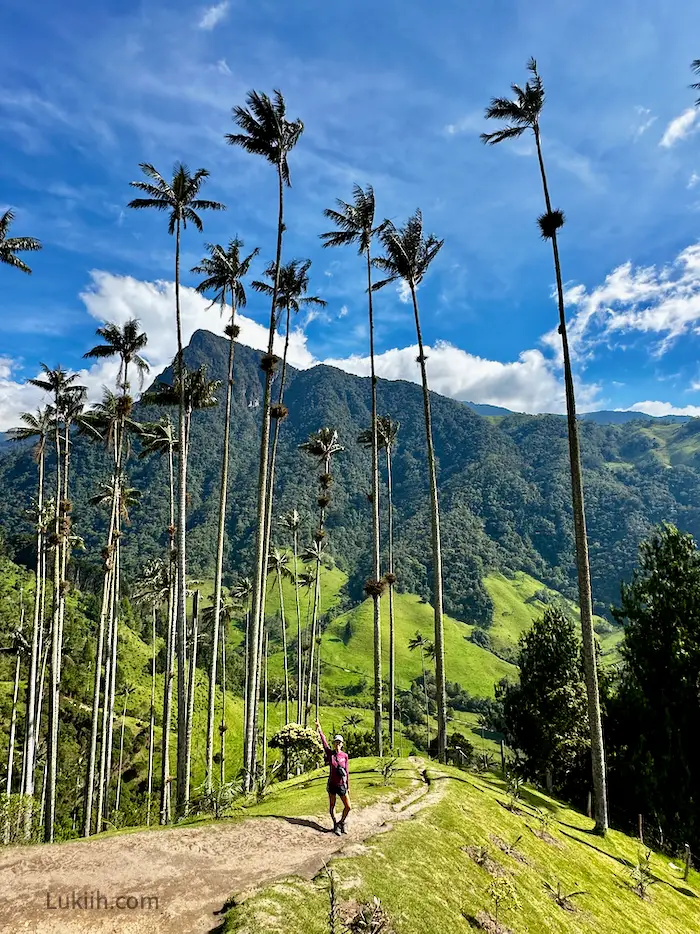
I include a detailed guide to Cocora Valley in my Colombia trip planner.
-
- Wabi Asian Kitchen – one of the better Asian restaurants I ate at in Colombia; the chef is Japanese
- Tentaciones Salentinas – my favorite dessert place in town; try their “fresas con crema”
- Kiwi Kafe – a tiny coffee place serving delicious croissant sandwiches
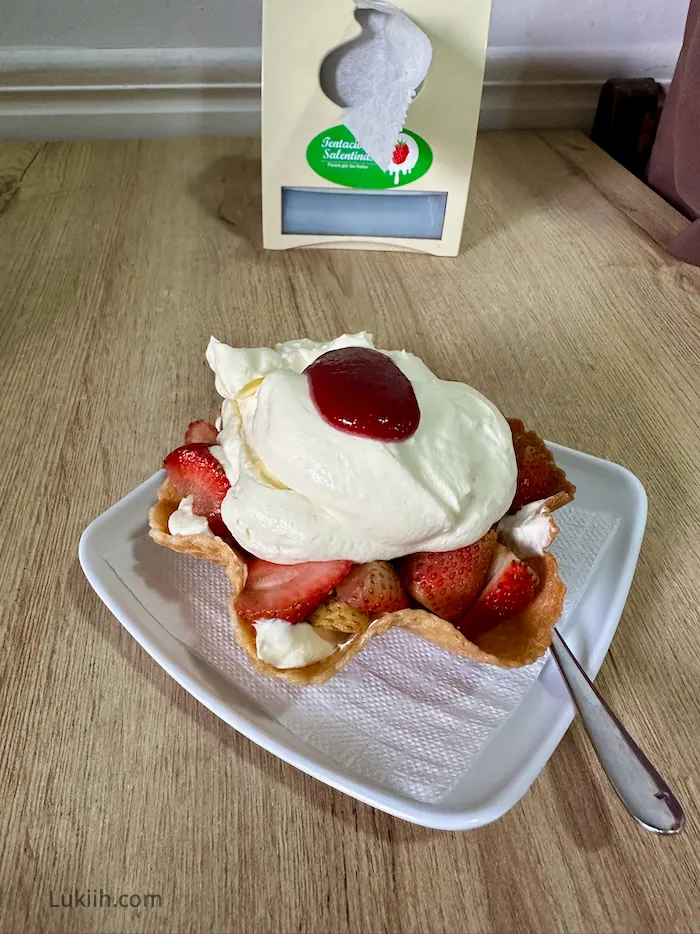
- From Medellín, you can fly to one of Salento’s closest airports in Pereira or Armenia, or take a 6-8 hour direct bus, which is what I did. Buses leave from Medellín’s Terminal del Sur.
- Because Salento is such a popular destination, accommodations are more expensive for what you get. The town is small, so you can stay anywhere and never have to walk more than 10 minutes to somewhere else. I didn’t stay at a great place and wished I had stayed in Terrazas de Salento instead.
Amazon Rainforest (Days 11-14, Option 2)
Finish your trip in Colombia’s Amazon Rainforest.
- The Amazon Rainforest, also known as the “lungs of the Earth” and the most biodiverse region of our planet, is mainly in 3 countries: Brazil, Peru, and Colombia. The Amazon infrastructure in Colombia is the least developed, so you’ll get the most authentic and off-the-beaten-path experience there.
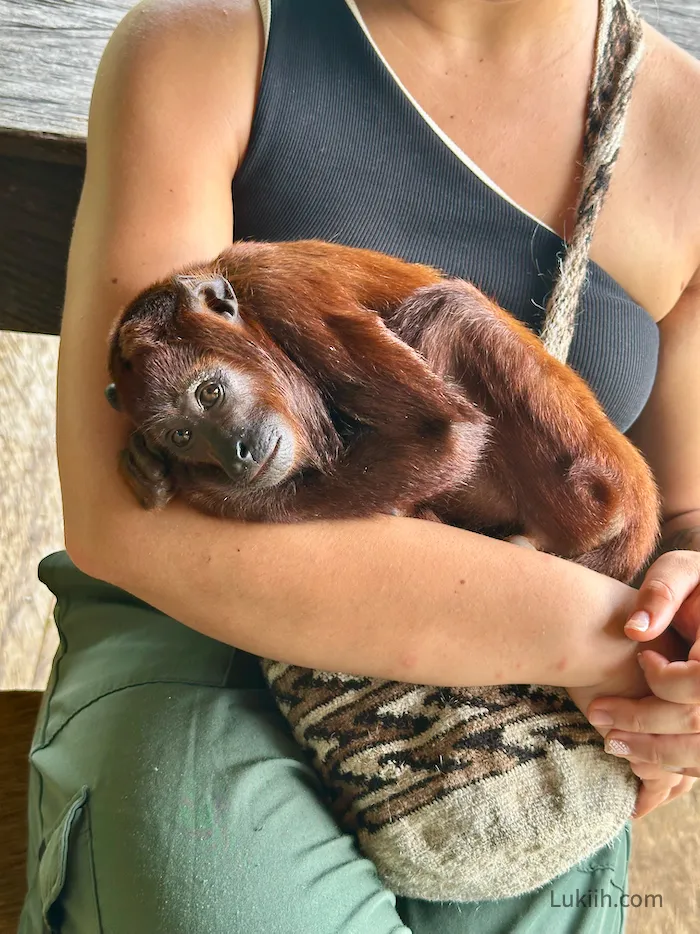
-
- Visit rescued monkeys in Fundación Maikuchig.
- See the largely untouched Ticuna village in San Martín.
- Swim and fish piranha in San Francisco Lake.
- Get a glimpse of the pink dolphins in the Amazon River.
- Meet a rescued howler monkey named Billy at Wochine Reserve.
- Taste copoazu ice cream for the first time in Puerto Nariño.
- Go on a night jungle hiking tour to see interesting insects and critters.
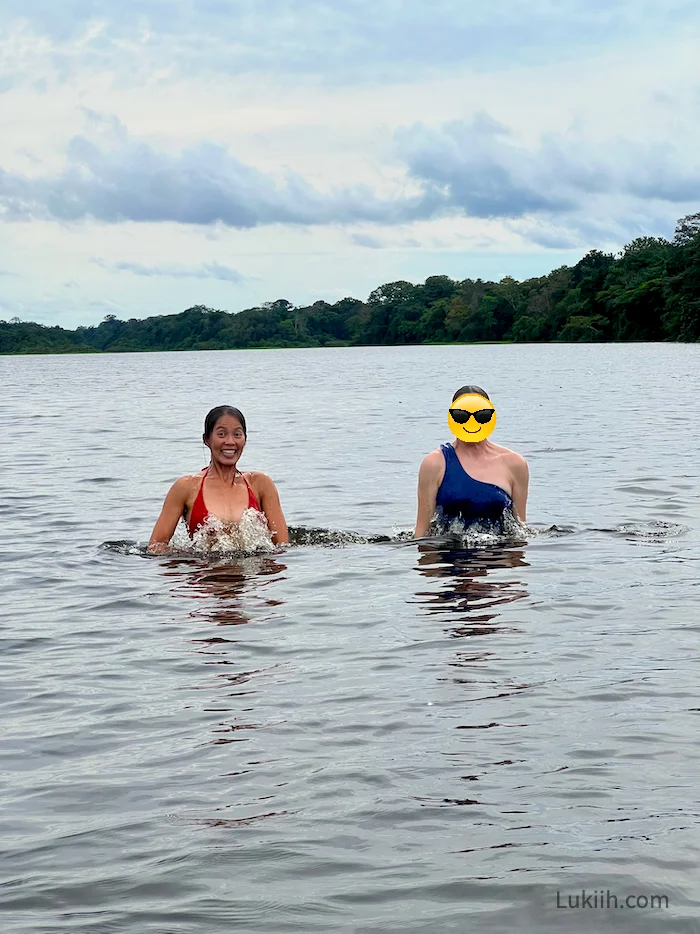
- To get to the Amazon Rainforest, you’ll have to fly into the gateway, the city of Leticia. From there, you’ll have to figure out the boat transportation to explore the rainforest or book a guided tour that will take you to various places.
- I booked my tour with Yoi EcoTours because of their ethics and high ratings and stayed at their relatively nice lodge.
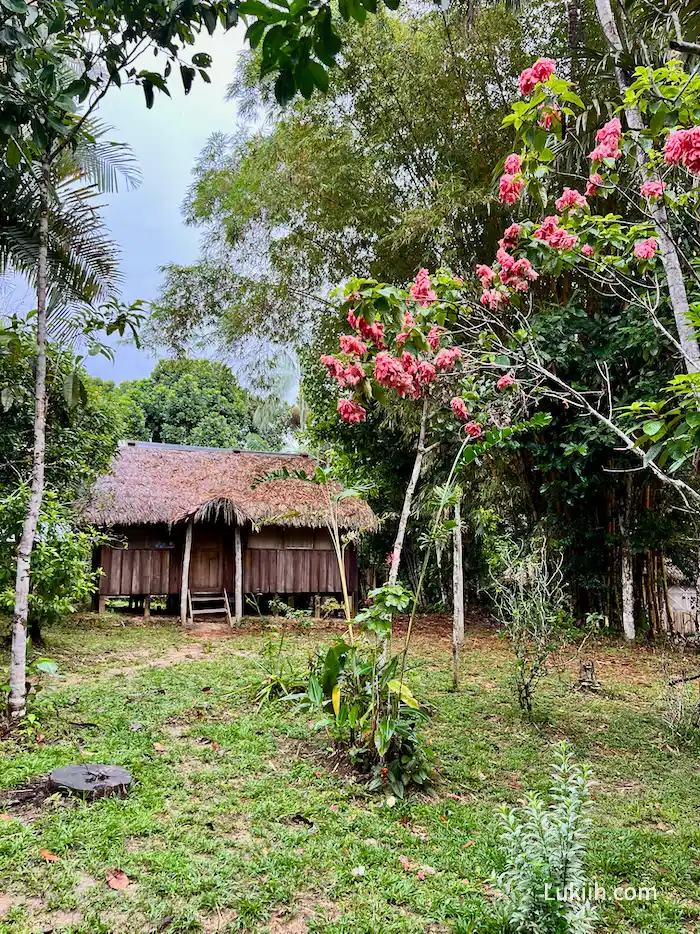
💰 My Colombia Trip Cost: Budget Breakdown (2025)
Colombia Trip Planner 2025
Make planning easier with my flexible, research-backed travel planner—shaped by real experience. It has:
- Up-to-date travel info
- A well-curated itinerary
- Practical, firsthand insights & tips
- A simple budget tracker
- A starter packing list
- Fully customizable sections
Built in Notion, this is the tool I personally use to plan every trip. I genuinely love it and creating a Notion account is free.
Lists by Lukiih is a small site I fund myself. Downloading my trip planner is the best way to support me and keep it running—thanks!
